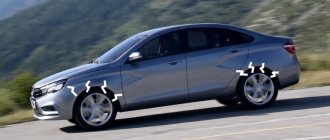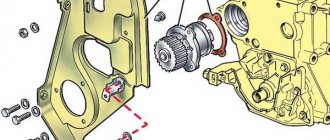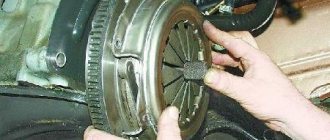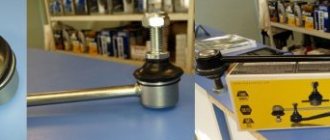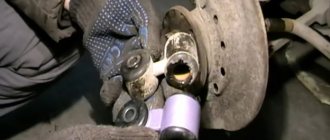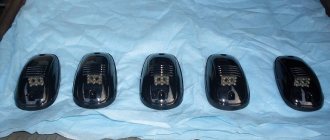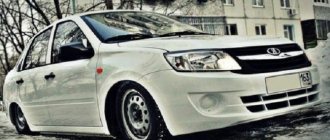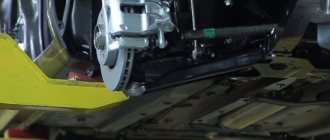Replacing an element such as stabilizer bushings on a Lada Vesta can be easily done with your own hands. It is for this reason that only inexperienced owners of cars of the model mentioned above turn to a car service center. As practice shows, often a specific and unpleasant squeak in the suspension area appears literally just a few days after purchasing a new vehicle. A simple inspection reveals that the problem lies in the stabilizer, which is responsible for its lateral stability (SST). In the aforementioned unit, the weak point turns out to be the bushing, or rather, the not very good material chosen “apparently – solely for the sake of economy” by the manufacturer for its manufacture.
Stabilizer - features
To better understand how to replace bushings with your own hands, you need to become familiar with the most common causes of their failure, be able to see signs of a malfunction and understand how the unit in question generally works.
The design of the front suspension mounted on the Lada Vesta was roughly copied from a similar Renault unit, but the domestic version turned out to be less advanced than the French prototype.
The torsion bar stabilizer is made from steel with high springiness. It itself is a rod that has a specific bend that helps reduce the lateral roll of the vehicle during turns at relatively high speeds. Without this element, the described maneuver may cause the vehicle to roll over.
In the case of Vesta, the stabilizer is installed exclusively on the front axle. The rod itself is fixed to the subframe with steel clamps and rubber bushings. From the edges the element is attached by levers to the suspension itself.
The operating principle of the stabilizer installed on the Lada Vesta is quite simple. The element distributes loads arising from any side evenly over the entire suspension. So, if the car begins to roll to one side, then the stabilizer rods change position. On the side where there is a critical slope, the node rises, and on the opposite side, on the contrary, it lowers.
The bushings that hold the front of the element allow it to rotate. This makes it possible to adjust the position of the body as the vehicle moves along the road. The stabilizer has another additional, but no less important function - improving the grip of the wheels on the road when entering a turn. Thus, the bushing takes on quite large loads, which contribute to the rapid failure of the part. Because of this, replacement (either with your own hands or in a car service) has to be done relatively often.
Replacing stabilizer bushings on Lada Vesta
Necessary tools, materials:
- Torx wrench with set of sockets;
- ring, ring wrenches;
- knob, heads;
- Silicone based lubricant.
Sequencing:
- We hang the car with a lifting mechanism.
- We turn on the first gear to lock the front wheel drive.
- Unscrew the bolts and remove the wheels and tires one by one.
- We unscrew the nuts of the upper and lower fastening of the stabilizer (bones), use the head at “17”.
- Using a key set to “17”, release the two bolts securing the metal bracket on the torsion bar on the left side. Access to the rubber bushing is unobstructed.
- To replace the bushing, first remove the steering rack protection on the right side. Fixation of the structure with five bolts, size “10”.
- Unscrew the right bushing.
- We unscrew the two rear bolts securing the metal bracket.
- We clean the surface of the torsion bar from dirt and deposits, and lubricate it with silicone grease.
- We put on new rubber seals.
- We assemble the structure in the reverse order with a tightening torque of 1.8-2.4 kgf.m.
Self-replacement of bushings on Lada Vesta is completed.
Note to the driver! It is not necessary to make a longitudinal cut when installing seals. The presence of an incision contributes to:
- penetration of sand, dirt, moisture into the gum;
- backlash formation;
- deformation of the seal.
When replacement is necessary
The failure of the stabilizer bushings on the Lada model under consideration is indicated by quite characteristic signs. So, in particular, on Vesta:
- there is a very loud creaking, and sometimes a knocking or even a grinding noise coming from the front suspension;
- the mentioned noises become especially loud if the car is moving on a bumpy road or after crossing a water obstacle;
- The car does not obey control well when the speed ranges from 60 to 90 kilometers per hour.
- when turning, the body rolls noticeably;
- turning the steering wheel requires more force.
Installation
In general, the algorithm for replacing standard stabilizer bushings with an analogue one is simple and, by and large, the same for components from the Chevrolet Niva and for parts from KIA. The only difference is that, in the case of parts from KIA, you will have to install the purchased bracket.
As for the Chevy Niva, the bushings from it will need to be modified - it is necessary to make a slot on the side, and then grind the sides down to the same size as on Vesta.
The replacement process itself begins with installing the Lada Vesta on the overpass, after which you need to thoroughly clean the bolts that secure the stabilizer bar from dirt. Next, you need to arm yourself with a wrench and a Torx T40 bit, with which one bolt from the bracket is completely unscrewed (located further from the steering rack). The second bolt is also unscrewed, but not completely, but enough so that the mounting bracket can be moved to the side.
When the bolts are unscrewed, all that remains is to move the bracket and remove the bushing itself. A pre-prepared bushing is placed in its place, and the bolts are tightened. The second element changes similarly.
This method works provided that components from ChevyNiva are used. If you decide to install bushings from KIA, you will have to completely remove the brackets. In this case, simply unscrewing the bolts will not work, since the screw, which is located closer to the steering rack, rests on the clamp that secures the rack boot.
It can be seen that it will not be possible to unscrew both bolts
In this situation there are 4 options:
- Turn the clamp itself;
- Rotate the boot (together with the clamp, of course);
- Remove the rack protection, then loosen its fastening bolts and slightly lift the rack up;
- Remove the rail completely.
This will allow you to replace the bracket along with the bushing.
And also the bracket from it
As you can see, there are several options for getting rid of creaking Lada Vesta bushings, which differ strikingly in both the effort involved and the financial and time costs.
This form provides general recommendations for eliminating squeaks.
There is a problem on the Lada Vesta car: the stabilizer bushings (struts) make a squeaking noise. Needless to say, on modern cars, besides the Lada Vesta, even on expensive ones, the problem of rubber bands is noticeable. The Lada Vesta stabilizer bushings begin to creak well and the struts quickly make themselves known. Creaking, knocking, non-functioning stabilizer bars appear so often on the Lada Vesta car - that AvtoVAZ even answered the question: why Vesta creaks so early. The price for such stabilizer struts and bushings is not high, but the sensations are not pleasant. By the way, the dealer changes the bushings under warranty. What to replace with: as an analogue, stabilizer bars from Kia Rio and Avensis are suitable for Lada Vesta - but this is after warranty. Polyurethane stabilizer bushings have proven themselves better - you can install them. Replacing components with your own hands takes 14 steps, more on them later in the article. The maximum weight of the Lada Vesta is 1670 kg. The Vesta is equipped with MacPherson strut suspension, a suspension that has been tested over years of operation on different types of vehicles. There is an opinion that the car is simply too heavy; for such stabilizers, they should be more powerful. On the Lada Vesta suspension, the stabilizer bushings are simply not slightly modified to accommodate the weight of the car. To understand the problem, let’s understand the principle of operation of the stabilization system of modern cars. There is nothing complicated about this. Everything works on the principle of a lever, which was invented by Archimedes at the beginning of the last millennium, read the article and find out about it
How to prevent the stabilizer from squeaking
Each owner tries to improve his car, eliminating the flaws made by the largest domestic manufacturer. Vesta’s owners continue the tradition. In particular, they often think about how to improve the performance of the stabilizer.
The easiest way to rid the Lada of squeaking is to thoroughly lubricate the bushings. To do this, it is permissible to use silicone compounds or even WD-40. This recommendation, by the way, is also present in the official operating manual for the machine. The problem is that this measure is not enough for a long time - sooner or later the lubricant dries out, so its layer has to be renewed regularly. Moreover, the owners note that the described measure helps only at first.
A more effective way is to replace the bushings. However, it is not very wise to use original products, because they will not last as long as their predecessors. Thus, the best way out is to use elements from foreign cars, and then the stabilizer will start working, albeit not silently, but much quieter.
Which bushings are suitable for Vesta
For those who are thinking about replacing the bushings with their own hands, we recommend throwing away the original rubber products and replacing them with polyurethane ones. It is easy to find them by article number - in the spare parts catalog they are designated as 17012680. This part has a similar internal diameter of 21.5 millimeters.
Bushings from:
- Chevrolet Niva 2123 (code – 17012680);
- Kia Rio (548132K100).
By the way, the fixing brackets from the last car (548141G000) will also work.
Which stabilizer bushings are suitable?
As already noted, the original parts are not of high quality. A worthy replacement should be found for them. There are several options to solve the problem:
Some enterprises are already producing polyurethane bushings for the Lada Vesta stabilizer. This material has better mechanical and chemical resistance than rubber. Install stabilizer bushings from KIA on Vesta. These parts are true to size and satisfying in quality.
Whether these are original Kia components or analogues does not matter.
Bushings for Kia and Lada Vesta
Both options give good results. Which one to prefer, you will have to decide for yourself. Buying the necessary components is not a problem. But it is not recommended to mount stabilizer bushings from Niva to Vesta. Like original parts, they may be of poor quality.
When purchasing parts from KIA for Vesta, you should make sure that their external and internal dimensions match! Otherwise they may not fit.
